2014 MERCEDES-BENZ B-CLASS SPORTS child lock
[x] Cancel search: child lockPage 8 of 360
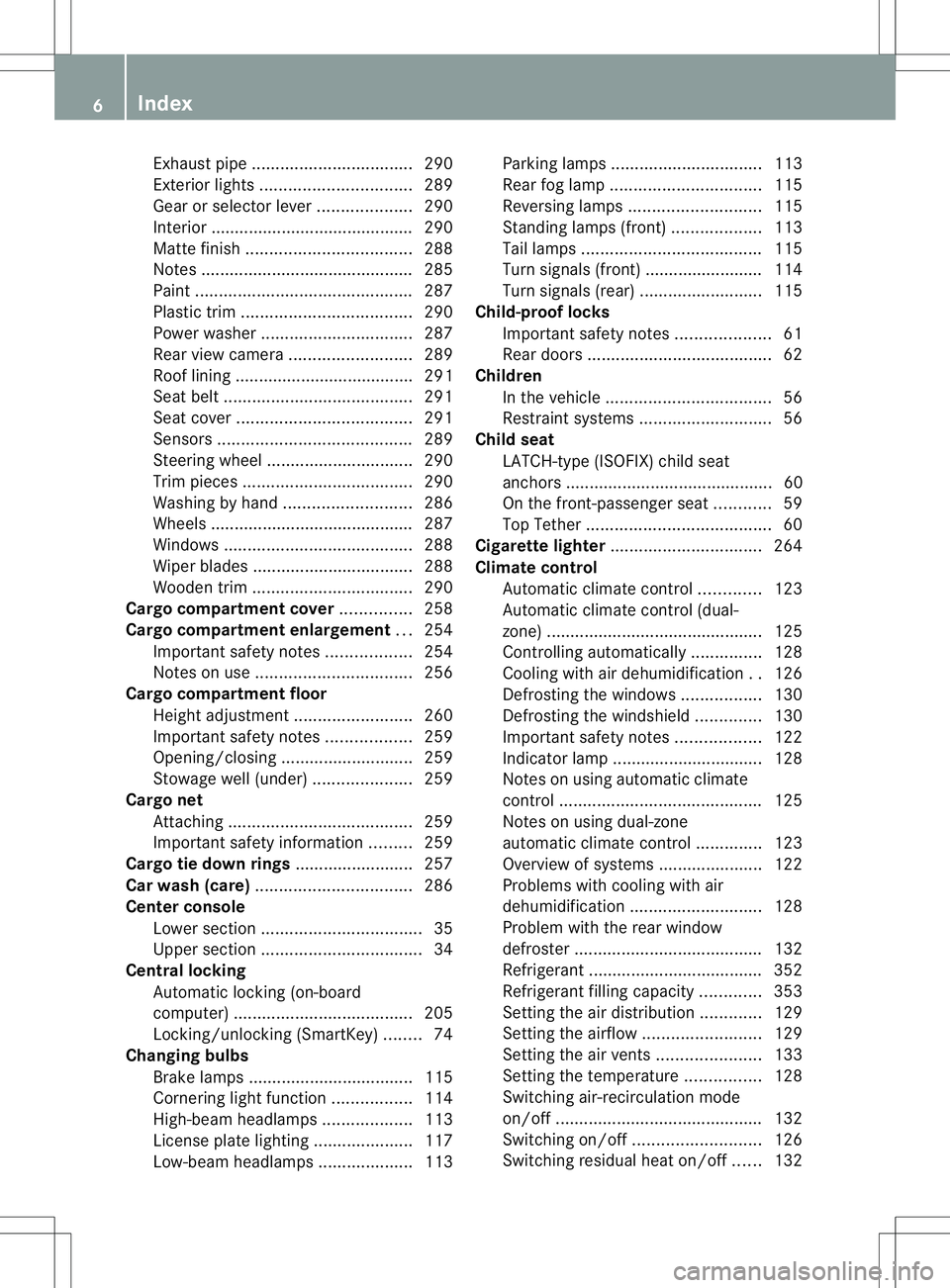
Exhaus
tpipe .................................. 290
Exterior lights ................................ 289
Gea rors electo rlever .................... 290
Interior ........................................... 290
Matte finish ................................... 288
Notes ............................................. 285
Paint .............................................. 287
Plastic trim .................................... 290
Power washer ................................ 287
Rea rview camera .......................... 289
Roo flining ...................................... 291
Seat bel t........................................ 291
Seat cover ..................................... 291
Sensors ......................................... 289
Steering wheel ............................... 290
Trim pieces .................................... 290
Washing by hand ........................... 286
Wheels ........................................... 287
Windows ........................................ 288
Wiper blades .................................. 288
Wooden trim .................................. 290
Cargo compartment cover ...............258
Cargo compartment enlargement ...254
Important safety notes ..................254
Notes on use ................................. 256
Cargo compartment floor
Height adjustment .........................260
Important safety notes ..................259
Opening/closing ............................ 259
Stowag ewell (under) ..................... 259
Cargo net
Attaching ....................................... 259
Important safety information .........259
Cargo tie dow nrings ......................... 257
Car wash (care) ................................. 286
Center console Lowe rsection .................................. 35
Uppe rsection .................................. 34
Central locking
Automatic locking (on-board
computer) ...................................... 205
Locking/unlocking (SmartKey) ........74
Changing bulbs
Brake lamps ................................... 115
Cornering light function .................114
High-beam headlamps ...................113
License plate lighting .....................117
Low-beam headlamps ....................113Parking lamps
................................ 113
Rea rfog lamp ................................ 115
Reversing lamps ............................ 115
Standing lamps (front) ...................113
Tai llamps ...................................... 115
Turn signals (front) ......................... 114
Turn signals (rear) ..........................115
Child-proof locks
Important safety notes ....................61
Rea rdoors ....................................... 62
Children
In the vehicle ................................... 56
Restraint systems ............................ 56
Child seat
LATCH-typ e(ISOFIX) chil dseat
anchors ............................................ 60
On the front-passenger sea t............ 59
Top Tether ....................................... 60
Cigarette lighter ................................ 264
Climate control Automatic climate control .............123
Automatic climate control (dual-
zone) .............................................. 125
Controlling automatically ...............128
Cooling with aird ehumidification..126
Defrosting the windows .................130
Defrosting the windshield ..............130
Important safety notes ..................122
Indicator lamp ................................ 128
Notes on using automatic climate
control ........................................... 125
Notes on using dual-zone
automatic climate control ..............123
Overview of systems ......................122
Problems with cooling with air
dehumidification ............................ 128
Problem with the rear window
defroster ........................................ 132
Refrigerant ..................................... 352
Refrigerant filling capacity .............353
Setting the aird istribution.............129
Setting the airflow .........................129
Setting the airv ents...................... 133
Setting the temperature ................128
Switching air-recirculation mode
on/off ............................................ 132
Switching on/off ........................... 126
Switching residua lheato n/off ......132 6
Index
Page 13 of 360
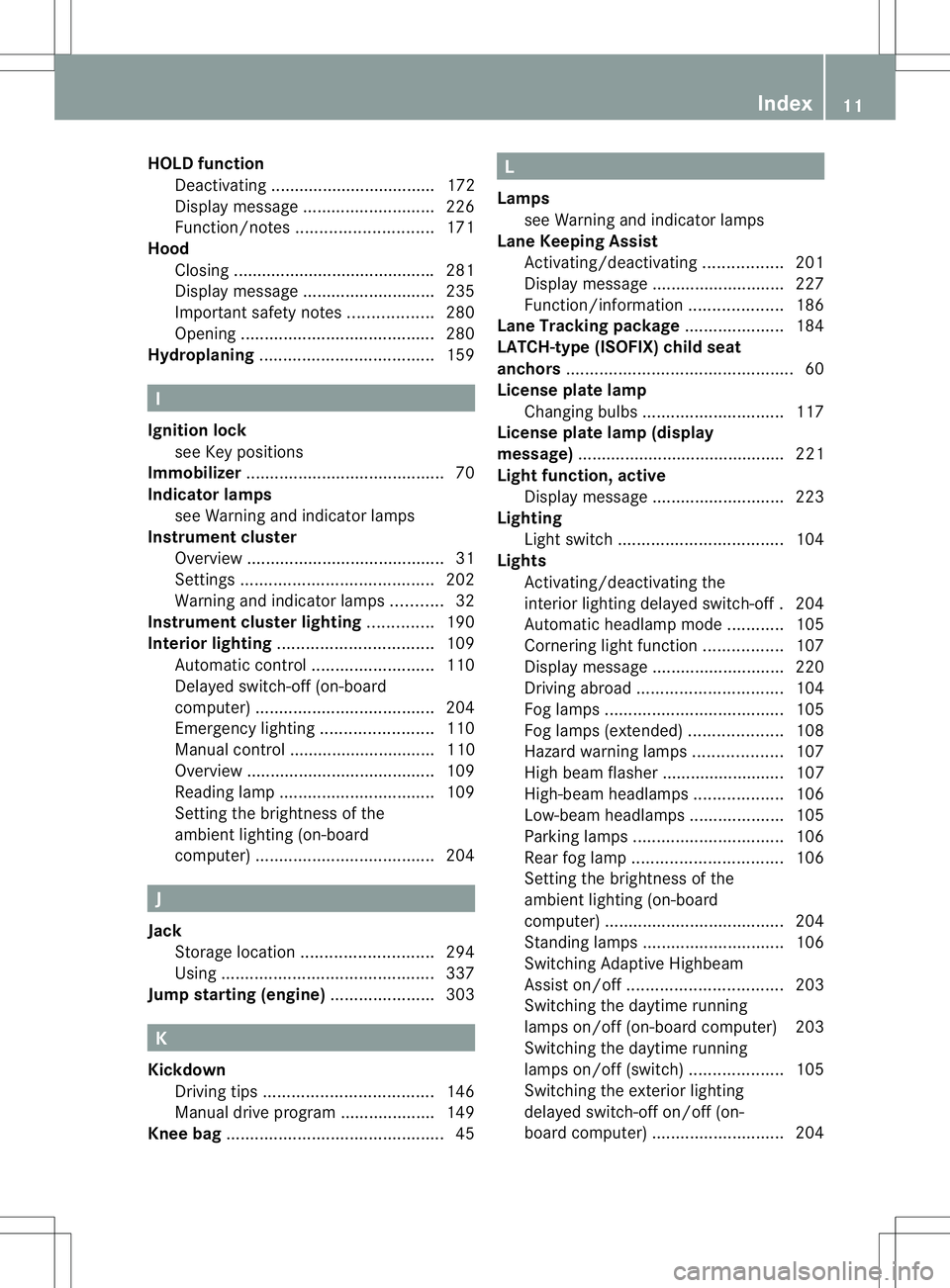
HOLD function
Deactivating ................................... 172
Display message ............................ 226
Function/notes ............................. 171
Hood
Closing .......................................... .281
Display message ............................ 235
Important safety notes ..................280
Opening ......................................... 280
Hydroplaning ..................................... 159I
Ignitio nlock
see Key positions
Immobilizer .......................................... 70
Indicator lamps see Warning and indicator lamps
Instrument cluster
Overview .......................................... 31
Settings ......................................... 202
Warning and indicator lamps ...........32
Instrument cluster lighting ..............190
Interior lighting ................................. 109
Automatic control ..........................110
Delayeds witch-off (on-board
computer) ...................................... 204
Emergency lighting ........................110
Manual control ............................... 110
Overview ........................................ 109
Reading lamp ................................. 109
Setting the brightness of the
ambient lighting (on-board
computer) ...................................... 204J
Jack Storage location ............................ 294
Using ............................................. 337
Jump starting (engine) ......................303 K
Kickdown Driving tips .................................... 146
Manual drive program ....................149
Kne ebag.............................................. 45 L
Lamps see Warning and indicator lamps
Lane Keepin gAssist
Activating/deactivating .................201
Display message ............................ 227
Function/informatio n.................... 186
Lane Tracking package .....................184
LATCH-type (ISOFIX) child seat
anchors ................................................ 60
Licens eplate lamp
Changing bulbs .............................. 117
Licens eplate lamp (display
message) ............................................ 221
Light function ,active
Display message ............................ 223
Lighting
Ligh tswitc h................................... 104
Lights
Activating/deactivating the
interio rlighting delayed switch-off .204
Automatic headlamp mode ............105
Cornering light function .................107
Display message ............................ 220
Driving abroad ............................... 104
Fog lamps ...................................... 105
Fog lamps (extended) ....................108
Hazard warning lamps ...................107
High bea mflasher .......................... 107
High-beam headlamps ...................106
Low-beam headlamps ....................105
Parking lamps ................................ 106
Rea rfog lamp ................................ 106
Setting the brightness of the
ambient lighting (on-board
computer) ...................................... 204
Standing lamps .............................. 106
Switching Adaptive Highbeam
Assist on/off ................................. 203
Switching the daytime running
lamps on/off (on-board computer) 203
Switching the daytime running
lamps on/off (switch) ....................105
Switching the exterio rlighting
delayed switch-off on/off (on-
board computer )............................ 204 Index
11
Page 41 of 360
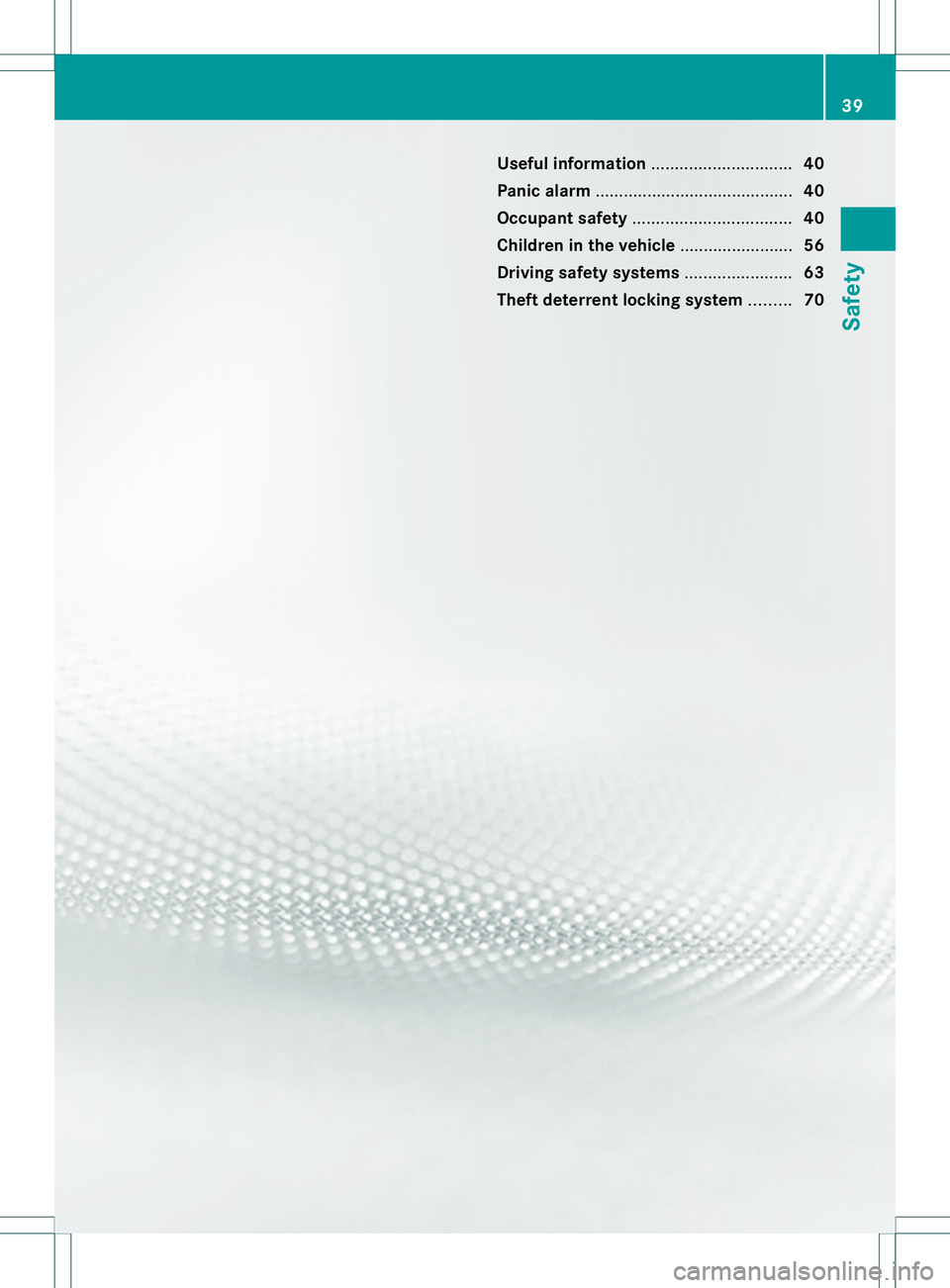
Useful information
..............................40
Panic alarm .......................................... 40
Occupant safety .................................. 40
Children in the vehicle ........................56
Driving safet ysystems ....................... 63
Thef tdeterrent locking system .........70 39Safety
Page 42 of 360
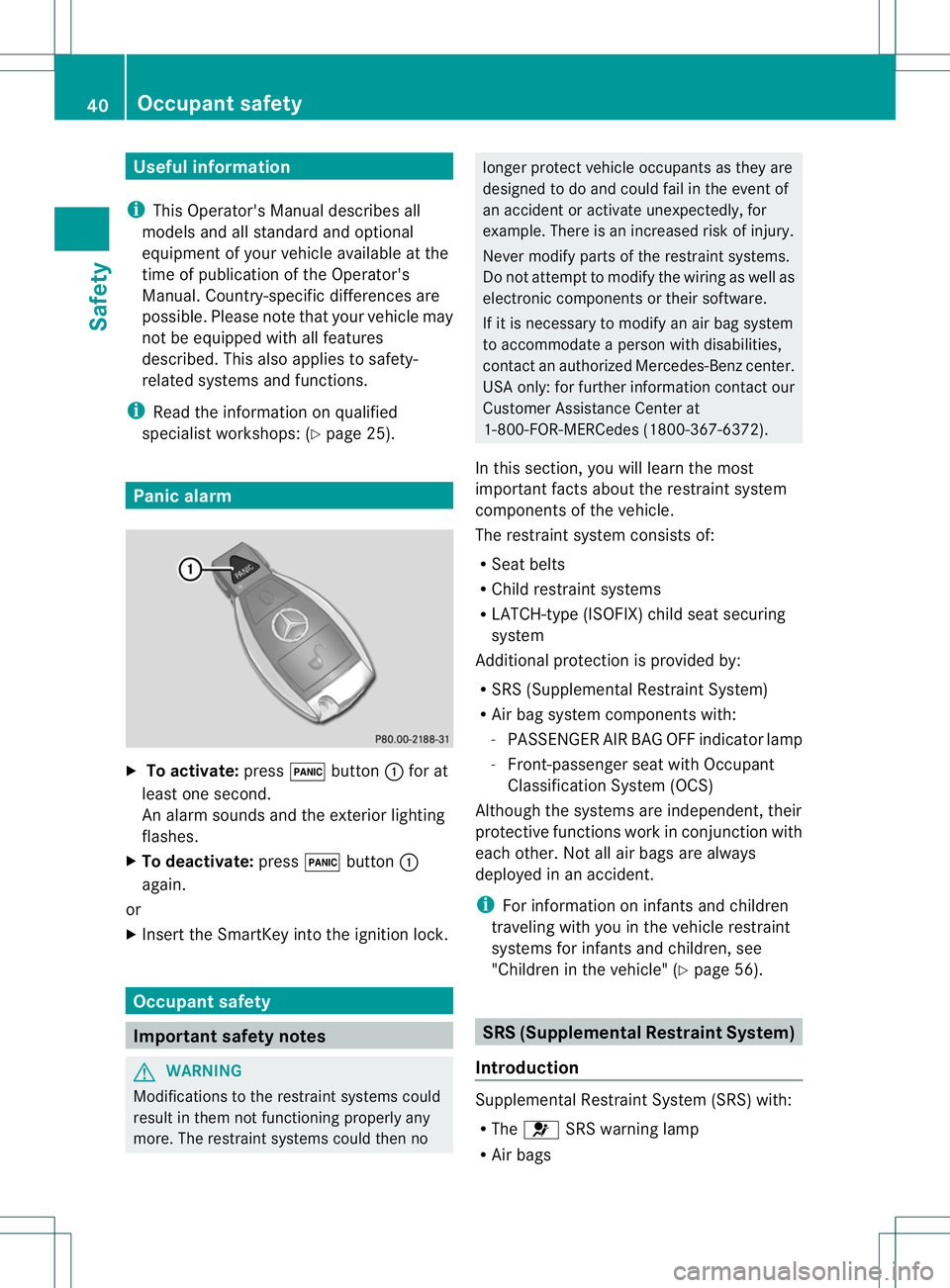
Useful information
i This Operator's Manual describes all
models and all standard and optional
equipment of your vehicle available at the
time of publication of the Operator's
Manual. Country-specific differences are
possible. Please not ethat your vehicle may
not be equipped with all features
described. This also applies to safety-
related system sand functions.
i Read the information on qualified
specialist workshops: (Y page 25).Panic alarm
X
To activate: press0004button 001Afor at
least one second.
An alarm sounds and the exterior lighting
flashes.
X To deactivate: press0004button 001A
again.
or
X Insert the SmartKey int othe ignition lock. Occupant safety
Important safet
ynotes G
WARNING
Modifications to the restraint system scould
result in them not functioning properly any
more. The restraint system scould then no longer protect vehicle occupants as they are
designed to do and could fail in the even
tof
an acciden toractivat eunexpectedly, for
example. Ther eisanincreased risk of injury.
Never modify part softherestraint systems.
Do no tattemp ttomodify the wiring as well as
electronic components or their software.
If it is necessary to modify an air bag system
to accommodat eaperson with disabilities,
contact an authorized Mercedes-Benz center.
USA only: for further information contact our
Customer Assistance Center at
1-800-FOR-MERCedes (1800-367-6372).
In this section ,you will learn the most
important facts about the restraint system
components of the vehicle.
The restraint system consist sof:
R Seat belts
R Child restraint systems
R LATCH-type (ISOFIX) child seat securing
system
Additional protection is provided by:
R SRS (Supplemental Restraint System)
R Air bag system components with:
-PASSENGER AIR BAG OFF indicator lamp
- Front-passenger seat with Occupant
Classification System (OCS)
Although the systems are independent ,their
protective functions work in conjunction with
each other. Not all air bags are always
deployed in an accident.
i For information on infant sand children
traveling with you in the vehicle restraint
systems for infant sand children, see
"Children in the vehicle" (Y page 56). SRS (Supplemental Restraint System)
Introduction Supplemental Restraint System (SRS) with:
R
The 0021 SRS warning lamp
R Air bags 40
Occupant safetySafety
Page 51 of 360
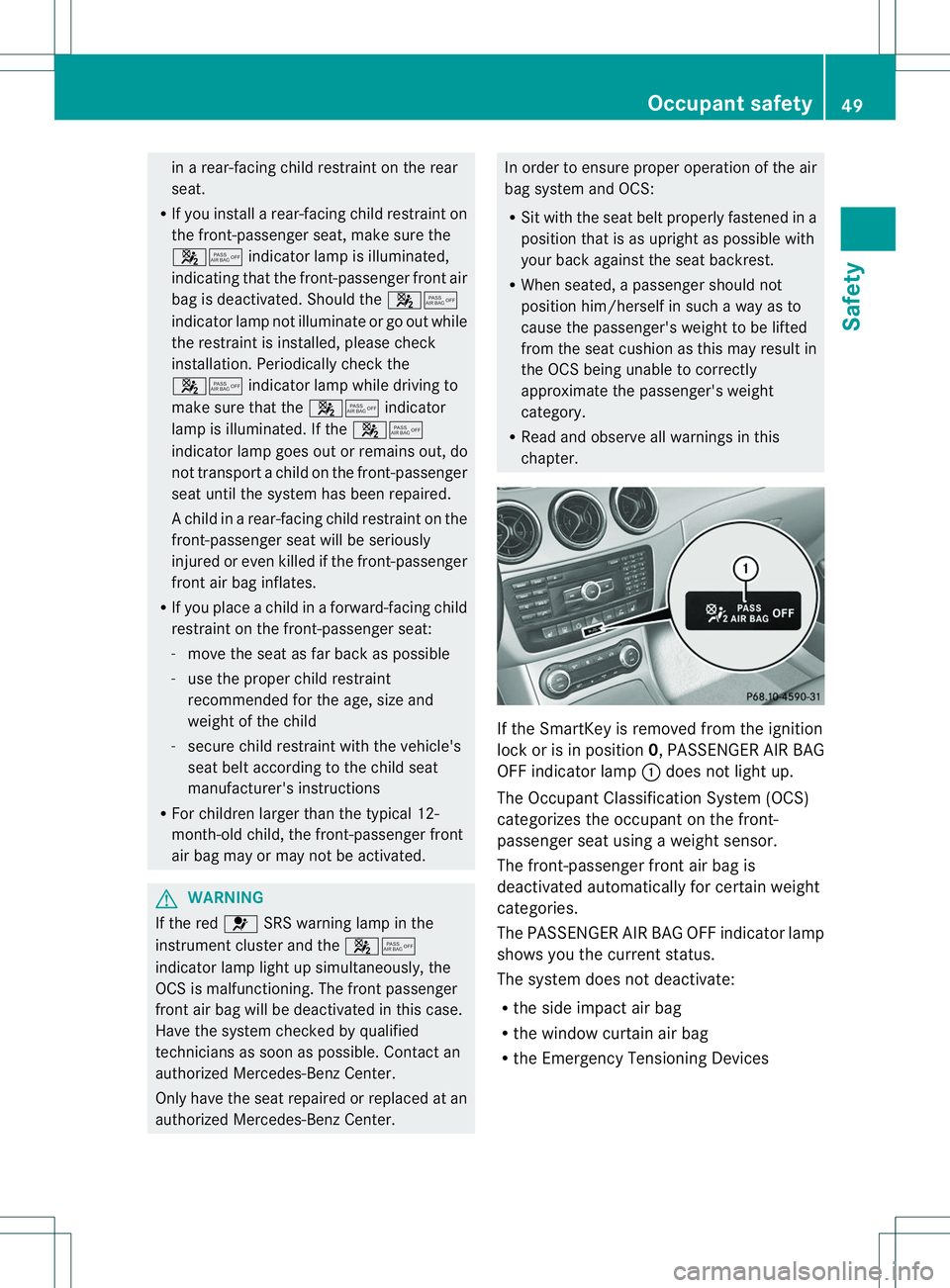
in
ar ear-facin gchild restraint on the rear
seat.
R If you install arear-facin gchild restraint on
the front-passenge rseat, make sure the
000E0013 indicator lamp is illuminated,
indicating that the front-passenger fron tair
bag is deactivated. Should the 000E0013
indicator lamp not illuminat eorgoout while
the restraint is installed, please check
installation .Periodically check the
000E0013 indicator lamp while driving to
make sure that the 000E0013indicator
lamp is illuminated. If the 000E0013
indicator lamp goes out or remains out, do
not transport achild on the front-passenger
seat until the system has been repaired.
Ac hild in arear-facing child restraint on the
front-passenger seat will be seriously
injured or even killed if the front-passenger
front air bag inflates.
R If you place achild in aforward-facing child
restraint on the front-passenger seat:
- move the seat as far back as possible
- use the proper child restraint
recommended for the age, size and
weight of the child
- secure child restraint with the vehicle's
seat belt according to the child seat
manufacturer's instructions
R For children larger than the typical 12-
month-old child, the front-passenger front
air bag may or may not be activated. G
WARNING
If the red 0021SRS warning lamp in the
instrument cluster and the 000E0013
indicator lamp light up simultaneously ,the
OCS is malfunctioning. The front passenger
front air bag will be deactivated in this case.
Have the system checked by qualified
technicians as soon as possible. Contact an
authorized Mercedes-Ben zCenter.
Only have the seat repaired or replaced at an
authorized Mercedes-Benz Center. In order to ensure proper operation of the air
bag system and OCS:
R
Sit with the seat belt properly fastened in a
position that is as upright as possible with
your back against the seat backrest.
R When seated, apassenger should not
position him/herself in such away as to
cause the passenger' sweight to be lifted
from the seat cushion as this may result in
the OCS being unable to correctly
approximat ethe passenger' sweight
category.
R Read and observe all warnings in this
chapter. If the SmartKey is removed from the ignition
lock or is in position 0,PASSENGER AIR BAG
OFF indicator lamp 001Adoes not light up.
The Occupant Classification System (OCS)
categorize sthe occupant on the front-
passenge rseat using aweight sensor.
The front-passenger fron tair bag is
deactivated automatically for certain weight
categories.
The PASSENGER AI RBAG OFF indicator lamp
shows yo uthe current status.
The system does not deactivate:
R the side impact ai rbag
R thew indow curtain air bag
R theE me rgency Tensioning Devices Occupant safety
49Safety Z
Page 52 of 360
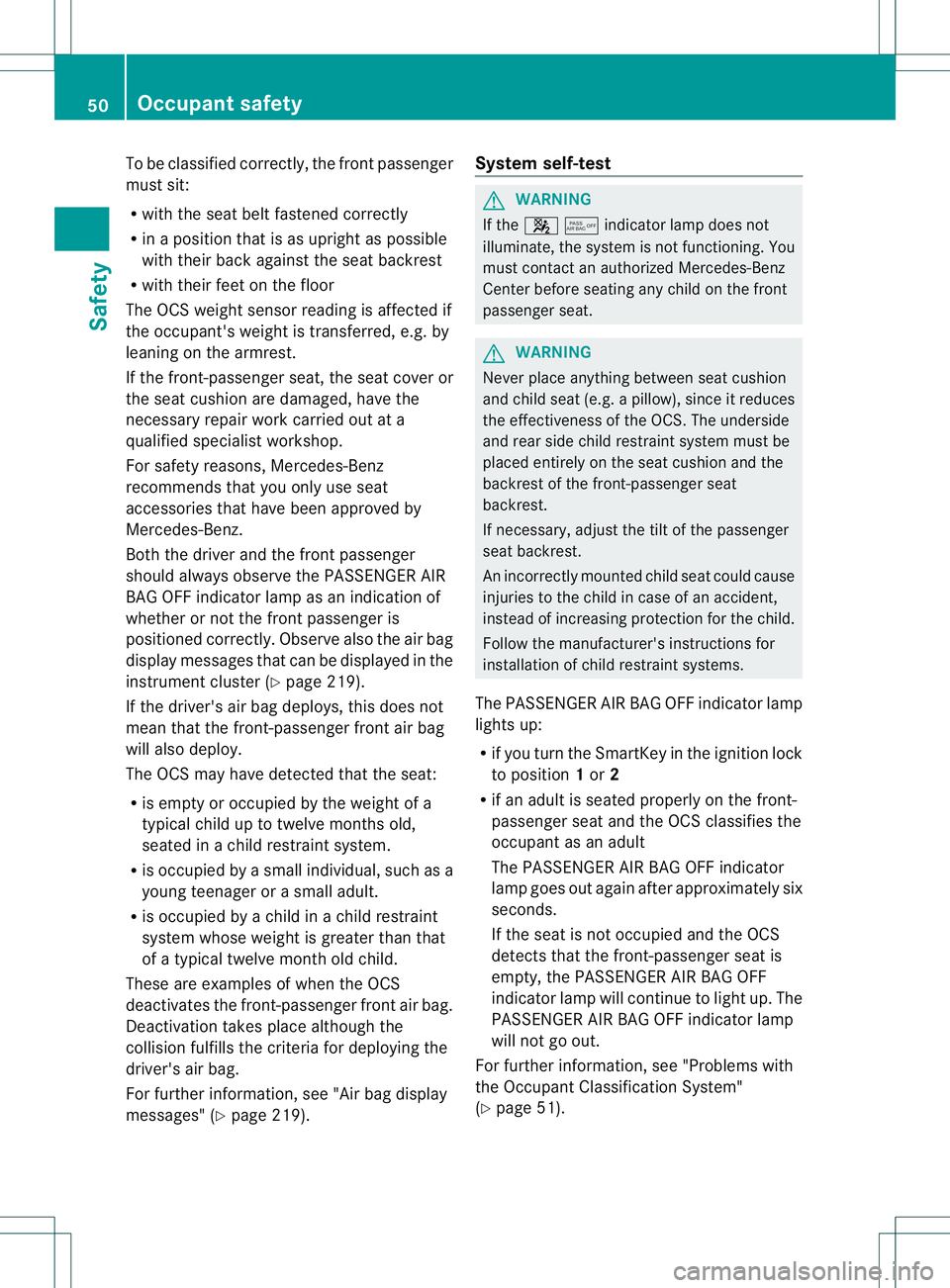
To be classified correctly, the frontp
assenger
must sit:
R wit hthe seat belt fastened correctly
R in ap ositio nthat is as upright as possible
with their back against the seat backrest
R with their feet on the floor
The OCS weight sensor reading is affected if
the occupant's weight is transferred, e.g. by
leaning on the armrest.
If the front-passenger seat, the seat cover or
the seat cushion are damaged, have the
necessary repair work carried out at a
qualified specialist workshop.
For safety reasons, Mercedes-Benz
recommends that you only use seat
accessories that have been approved by
Mercedes-Benz.
Both the driver and the front passenger
should always observe the PASSENGER AIR
BAG OFF indicator lamp as an indication of
whether or not the front passenger is
positioned correctly. Observe also the air bag
displaym essages that can be displayed in the
instrumentc luster (Ypage 219).
If the driver's air bag deploys, this does not
mean that the front-passenger front air bag
will also deploy.
The OCS may have detected that the seat:
R is empty or occupied by the weight of a
typical child up to twelve months old,
seated in achild restraint system.
R is occupied by asmall individual, such as a
young teenager or asmall adult.
R is occupied by achild in achild restraint
system whose weight is greater than that
of at ypical twelve montho ld child.
These are examples of when the OCS
deactivates the front-passenger front air bag.
Deactivation takes place although the
collision fulfills the criteria for deploying the
driver's air bag.
For further information ,see "Air bag display
messages" (Y page 219). System self-test G
WARNING
If the 000E0013indicator lamp does not
illuminate, the system is not functioning. You
must contac tanauthorized Mercedes-Benz
Center befor eseatin gany child on the front
passenger seat. G
WARNING
Never place anything betwee nseat cushion
and child seat (e.g. apillow), since it reduces
the effectiveness of the OCS. The underside
and rear side child restraint system must be
placed entirely on the seat cushion and the
backrest of the front-passenger seat
backrest.
If necessary, adjust the tilt of the passenger
seat backrest.
An incorrectly mounted child seat could cause
injuries to the child in case of an accident,
instead of increasing protection for the child.
Follow the manufacturer's instructions for
installation of child restraint systems.
The PASSENGER AIR BAG OFF indicator lamp
lights up:
R if you turn the SmartKey in the ignition lock
to position 1or 2
R if an adult is seated properly on the front-
passenger seat and the OCS classifies the
occupant as an adult
The PASSENGER AIR BAG OFF indicator
lamp goes out again after approximately six
seconds.
If the seat is not occupied and the OCS
detects that the front-passenger seat is
empty, the PASSENGER AIR BAG OFF
indicator lamp will continue to light up. The
PASSENGER AIR BAG OFF indicator lamp
will not go out.
For further information ,see "Problems with
the Occupant Classification System"
(Y page 51). 50
Occupant safetySafety
Page 58 of 360
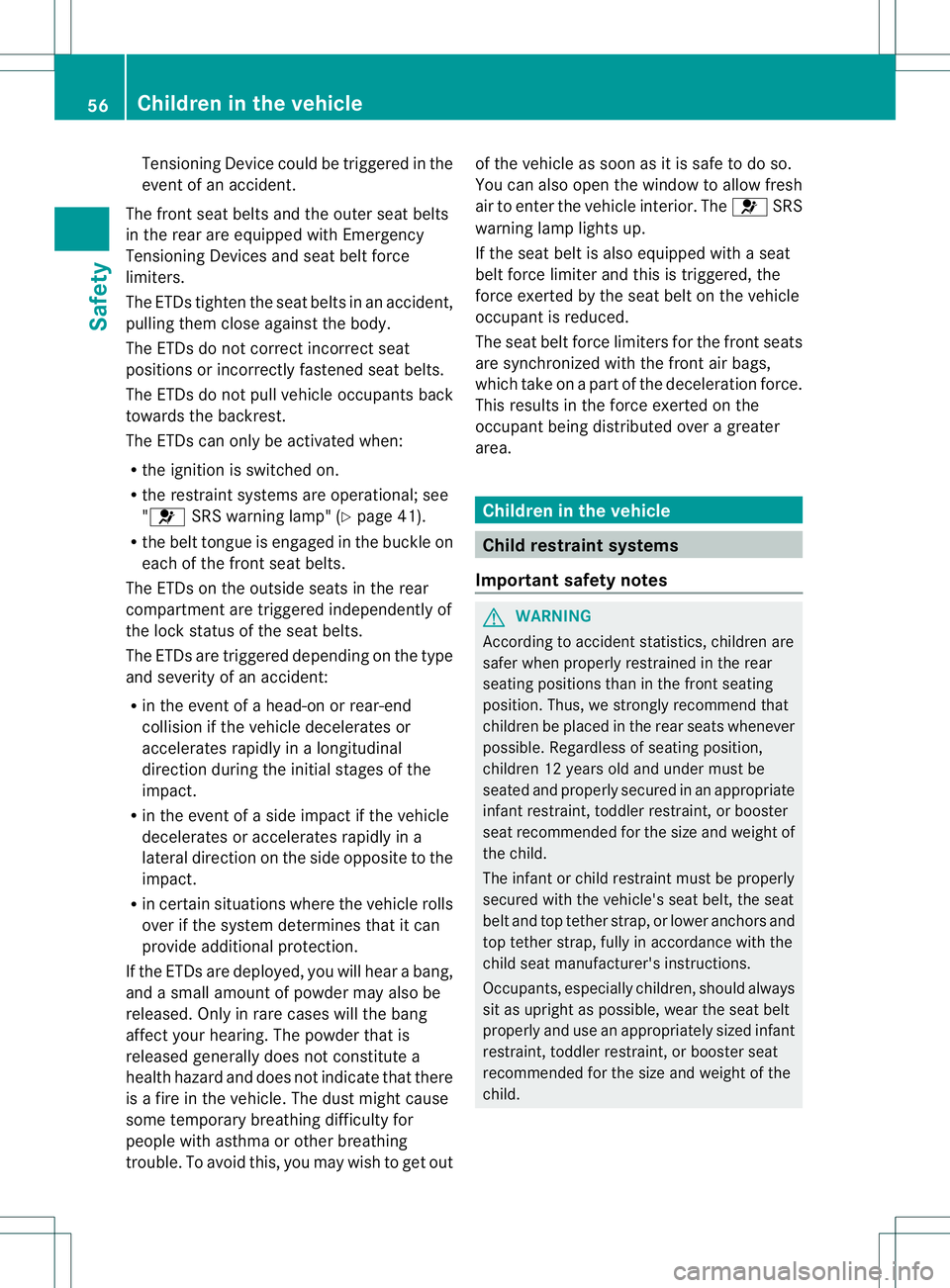
Tensionin
gDevice could be triggered in the
event of an accident.
The fronts eat belts and the outer seat belts
in the rear are equipped with Emergency
Tensioning Devices and seat belt force
limiters.
The ETDst ighten the seat belts in an accident,
pulling them close against the body.
The ETDsdon ot correct incorrect seat
position sorincorrectly fastened seat belts.
The ETDsdon ot pull vehicle occupants back
towards the backrest.
The ETDsc an only be activated when:
R the ignition is switched on.
R the restraint systems are operational; see
"0021 SRS warning lamp" (Y page 41).
R the belt tongue is engaged in the buckle on
each of the fron tseat belts.
The ETDsont he outside seats in the rear
compartment are triggered independently of
the lock status of the seat belts.
The ETDsa re triggered depending on the type
and severit yofanaccident:
R in the event of ahead-on or rear-end
collision if the vehicle decelerates or
accelerates rapidly in alongitudinal
direction during the initial stages of the
impact.
R in the event of aside impact if the vehicle
decelerates or accelerates rapidly in a
lateral direction on the side opposite to the
impact.
R in certain situation swhere the vehicle rolls
over if the system determines that it can
provide additional protection.
If the ETDsa re deployed, you will hear abang,
and asmall amount of powder may also be
released. Only in rare cases will the bang
affect your hearing. The powder that is
released generally does not constitute a
health hazard and does not indicat ethat there
is af ire in the vehicle. The dust might cause
some temporary breathin gdifficult yfor
people with asthma or other breathing
trouble. To avoid this, you may wish to get out of the vehicle as soon as it is safe to do so.
You can also open the window to allow fresh
air to enter the vehicle interior. The
0021SRS
warning lamp lights up.
If the seat belt is also equipped with aseat
belt forc elimiter and this is triggered, the
forc eexerted by the seat belt on the vehicle
occupant is reduced.
The seat belt force limiters for the front seats
are synchronized with the front air bags,
which take on apart of the deceleration force.
This results in the force exerted on the
occupant being distributed over agreater
area. Children in the vehicle
Child restraint systems
Important safety notes G
WARNING
According to accident statistics, children are
safer when properly restrained in the rear
seating positions than in the front seating
position. Thus, we strongly recommend that
children be placed in the rear seats whenever
possible.R egardless of seating position,
children 12 years old and under must be
seated and properly secured in an appropriate
infant restraint, toddler restraint, or booster
seat recommended for the size and weight of
the child.
The infant or child restraint must be properly
secured with the vehicle's seat belt, the seat
belt and top tether strap, or lower anchor sand
top tether strap, fully in accordance with the
child seat manufacturer's instructions.
Occupants, especially children ,should always
sit as upright as possible, wear the seat belt
properly and use an appropriately sized infant
restraint, toddler restraint, or booster seat
recommended for the size and weight of the
child. 56
Children in thev
ehicleSafety
Page 60 of 360
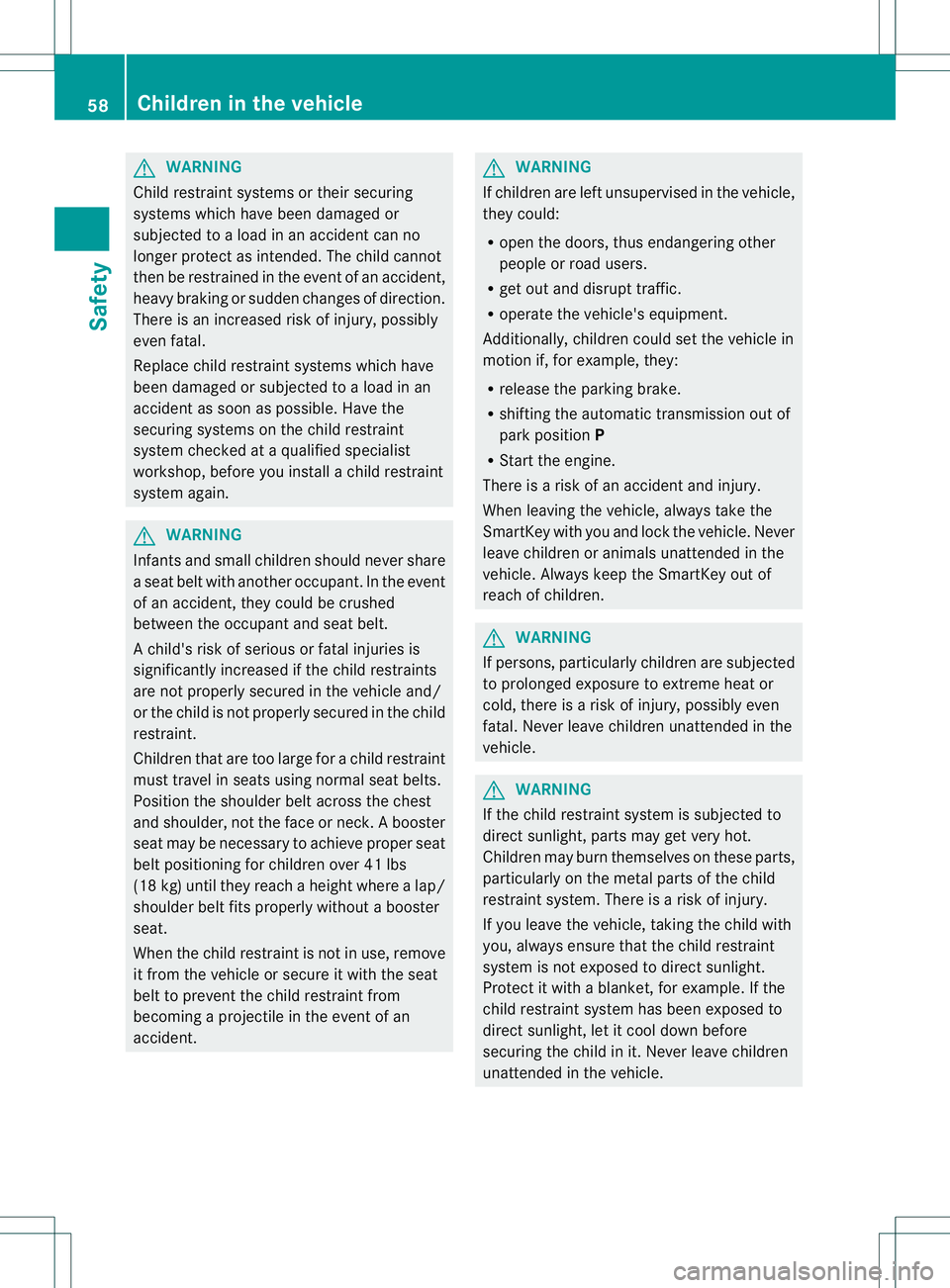
G
WARNING
Child restraint systems or their securing
systems which have been damaged or
subjected to aloa dinana ccident can no
longer protect as intended. The child cannot
then be restrained in the event of an accident,
heavy braking or sudden changes of direction.
There is an increased risk of injury ,possibly
even fatal.
Replace child restraint systems which have
been damaged or subjected to aloa dinan
accident as soon as possible.H ave the
securin gsystems on th echild restraint
system checked at aqualified specialist
workshop ,before you install achild restraint
system again. G
WARNING
Infants and small childre nshould never share
as eat belt with another occupant. In the event
of an accident, they could be crushed
between the occupant and seat belt.
Ac hild's risk of serious or fatal injuries is
significantly increased if the child restraints
are not properly secured in the vehicle and/
or the child is not properly secured in the child
restraint.
Children that are too large for achild restraint
must travel in seats using normal seat belts.
Position the shoulder belt across the chest
and shoulder, not the face or neck.Ab ooster
seat may be necessary to achieve proper seat
belt positioning for children over 41 lbs
(18 kg )until they reach aheight where alap/
shoulder belt fit sproperly without abooster
seat.
When th echild restraint is no tinuse, remove
it from the vehicle or secure it with the seat
belt to prevent the child restraint from
becoming aprojectile in the event of an
accident. G
WARNING
If children are left unsupervised in the vehicle,
they could:
R open the doors, thus endangering other
people or road users.
R get out and disrupt traffic.
R operate the vehicle's equipment.
Additionally, children could set the vehicle in
motion if, for example, they:
R release the parking brake.
R shifting the automatic transmission out of
park position P
R Start the engine.
There is arisk of an accident and injury.
When leaving the vehicle, always take the
SmartKey with you and lock the vehicle. Never
leave children or animals unattended in the
vehicle. Always keep the SmartKey out of
reach of children. G
WARNING
If persons, particularly children are subjected
to prolonged exposure to extreme heat or
cold, there is arisk of injury, possibly even
fatal. Never leave children unattended in the
vehicle. G
WARNING
If the child restraint system is subjected to
direct sunlight, parts may get very hot.
Children may burn themselves on these parts,
particularly on the metal parts of the child
restraint system. There is arisk of injury.
If you leave the vehicle, taking the child with
you, always ensure that the child restraint
system is not exposed to direct sunlight.
Protect it with ablanket, for example. If the
child restraint system has been exposed to
direct sunlight, let it cool down before
securing the child in it. Never leave children
unattended in the vehicle. 58
Children in the vehicleSafety